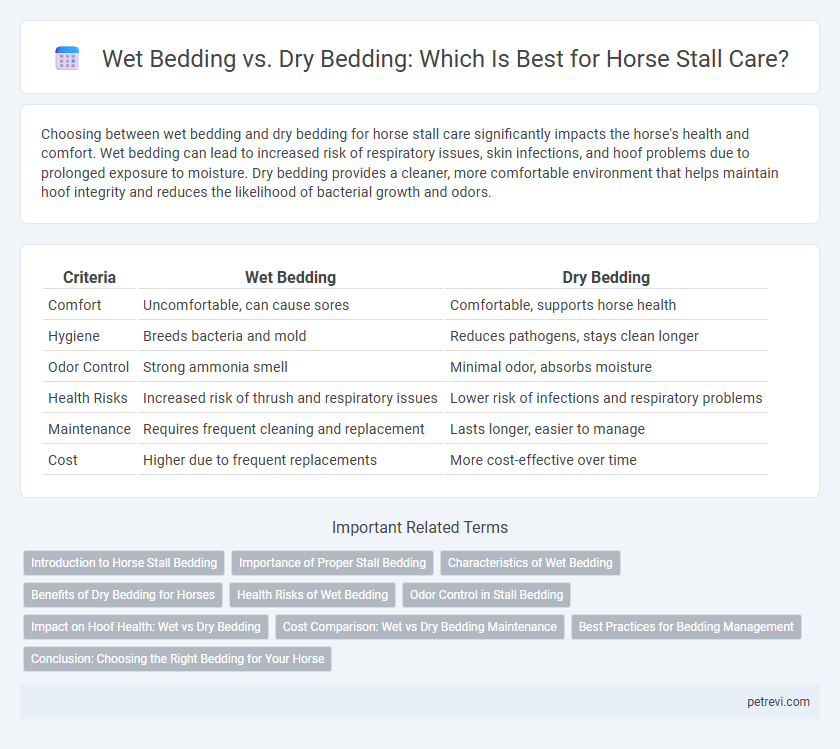Choosing between wet bedding and dry bedding for horse stall care significantly impacts the horse's health and comfort. Wet bedding can lead to increased risk of respiratory issues, skin infections, and hoof problems due to prolonged exposure to moisture. Dry bedding provides a cleaner, more comfortable environment that helps maintain hoof integrity and reduces the likelihood of bacterial growth and odors.
Table of Comparison
| Criteria | Wet Bedding | Dry Bedding |
|---|---|---|
| Comfort | Uncomfortable, can cause sores | Comfortable, supports horse health |
| Hygiene | Breeds bacteria and mold | Reduces pathogens, stays clean longer |
| Odor Control | Strong ammonia smell | Minimal odor, absorbs moisture |
| Health Risks | Increased risk of thrush and respiratory issues | Lower risk of infections and respiratory problems |
| Maintenance | Requires frequent cleaning and replacement | Lasts longer, easier to manage |
| Cost | Higher due to frequent replacements | More cost-effective over time |
Introduction to Horse Stall Bedding
Horse stall bedding plays a crucial role in maintaining the health and comfort of horses by providing a clean, dry resting area that reduces the risk of injuries and infections. Wet bedding can lead to increased ammonia levels and bacterial growth, which may cause respiratory issues and hoof problems such as thrush. Choosing dry bedding materials like wood shavings, straw, or paper helps promote better hygiene, proper moisture absorption, and enhances overall stall cleanliness.
Importance of Proper Stall Bedding
Proper stall bedding is crucial for horse health, providing comfort and moisture control essential to prevent hoof diseases like thrush. Wet bedding increases the risk of bacterial growth and skin irritations, compromising the horse's well-being and leading to costly veterinary care. Choosing dry bedding materials such as shavings or straw ensures a clean, dry environment that supports optimal hoof and respiratory health.
Characteristics of Wet Bedding
Wet bedding in horse stalls retains moisture, promoting bacterial growth and increasing the risk of hoof diseases like thrush and white line disease. It also causes discomfort and skin irritation, potentially leading to conditions such as mud fever or dermatitis. Proper management requires frequent cleaning and replacement to maintain hygiene and horse health.
Benefits of Dry Bedding for Horses
Dry bedding in horse stalls promotes superior hoof health by reducing moisture-related issues such as thrush and infections, enhancing overall comfort and cleanliness. It helps maintain a stable, odor-free environment that minimizes ammonia buildup, improving respiratory health for horses. Furthermore, dry bedding supports better absorption of urine, leading to easier stall maintenance and prolonged bedding lifespan.
Health Risks of Wet Bedding
Wet bedding in horse stalls significantly increases the risk of respiratory issues such as heaves and bronchitis due to elevated ammonia levels and mold growth. Prolonged exposure to damp conditions promotes bacterial infections and skin problems like thrush and rain rot, impacting hoof and coat health. Maintaining dry bedding reduces moisture-related pathogens, supporting optimal respiratory function and overall equine well-being.
Odor Control in Stall Bedding
Wet bedding in horse stalls often leads to increased ammonia buildup, causing strong odors that can irritate the horse's respiratory system. Dry bedding, such as shavings or straw, effectively absorbs moisture and reduces odor by minimizing bacterial growth. Proper stall ventilation combined with dry bedding ensures optimal odor control and promotes a healthier environment for horses.
Impact on Hoof Health: Wet vs Dry Bedding
Wet bedding in horse stalls increases the risk of hoof problems such as thrush and abscesses due to constant moisture exposure, which softens the hoof wall and sole. Dry bedding promotes better hoof health by maintaining a clean, dry environment that prevents bacterial and fungal growth. Regular stall cleaning and proper moisture control are essential to minimizing hoof diseases and ensuring optimal horse hoof condition.
Cost Comparison: Wet vs Dry Bedding Maintenance
Dry bedding materials such as wood shavings or straw typically incur higher initial costs compared to wet bedding options like sand or rubber mats, but they offer easier maintenance and better absorption that reduces overall stall cleaning frequency. Wet bedding requires more frequent replacement and thorough drying, increasing labor and water usage expenses, which can lead to higher long-term maintenance costs despite lower upfront prices. Choosing between wet and dry bedding for horse stalls hinges on balancing initial investment against ongoing care expenses, with dry bedding often proving more cost-effective in terms of stall hygiene and horse health.
Best Practices for Bedding Management
Effective horse stall care requires selecting the right bedding to maintain comfort and hygiene; wet bedding can harbor bacteria, leading to hoof issues and respiratory problems, while dry bedding promotes a healthier environment by reducing moisture and odors. Best practices include regular removal of soiled bedding, thorough stall cleaning, and ensuring adequate ventilation to keep the bedding dry and fresh. Using absorbent materials like wood shavings or straw enhances moisture control and provides cushioning, supporting overall equine health and well-being.
Conclusion: Choosing the Right Bedding for Your Horse
Selecting the right bedding for your horse depends on factors such as climate, horse health, and stall maintenance frequency. Wet bedding can increase ammonia levels leading to respiratory issues, while dry bedding promotes better hoof health and comfort. Prioritizing dry, absorbent materials like shavings or straw ensures a cleaner, safer environment conducive to your horse's overall well-being.
Wet Bedding vs Dry Bedding for Horse Stall Care Infographic

 petrevi.com
petrevi.com